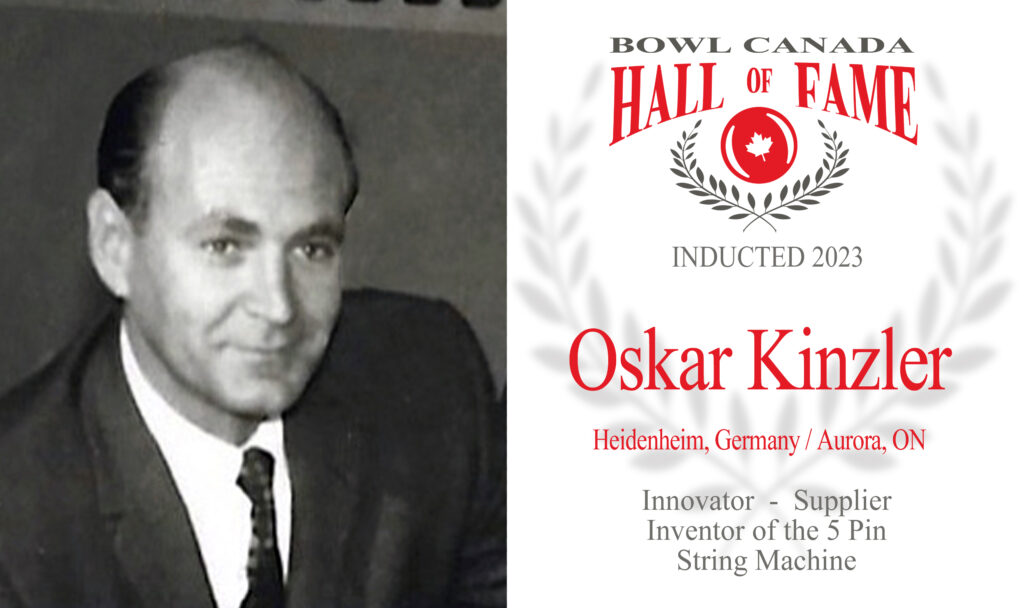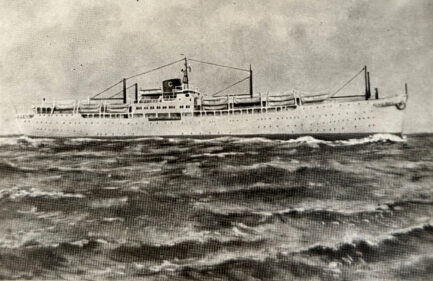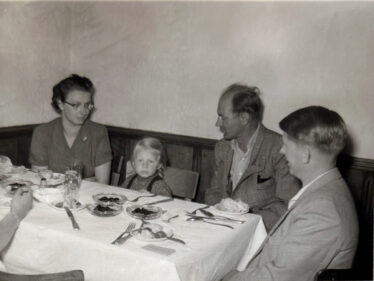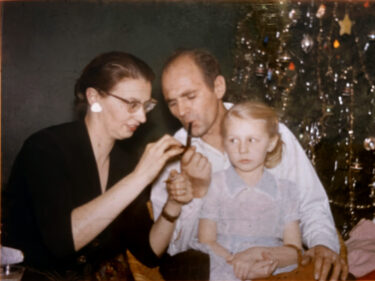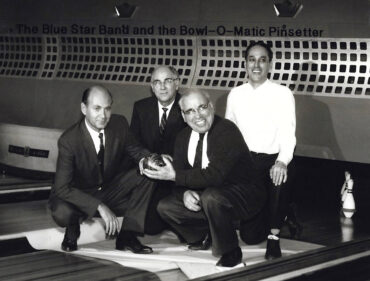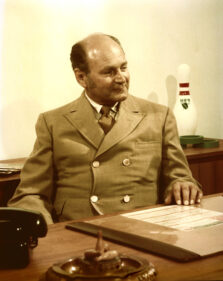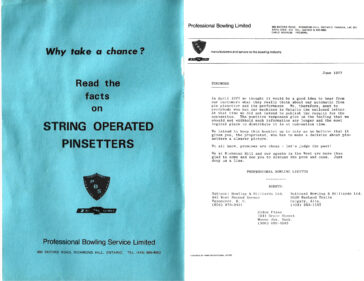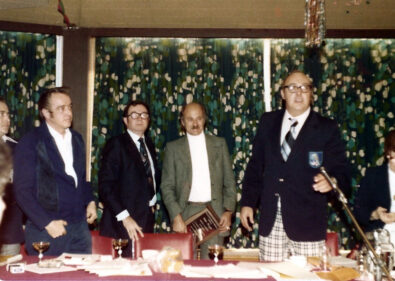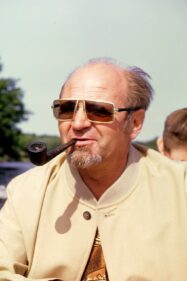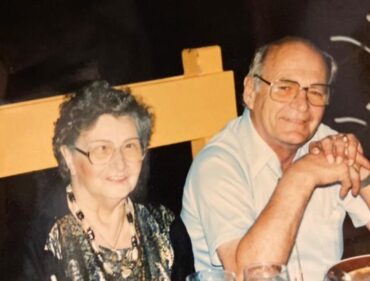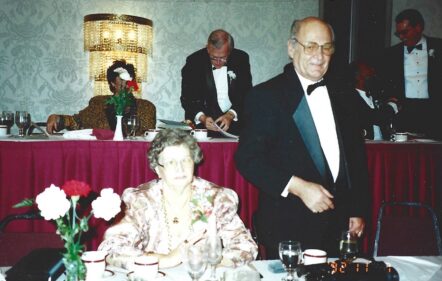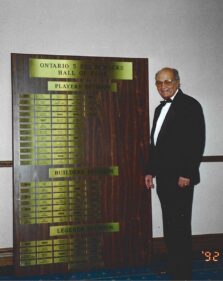RETURN TO HALL OF FAME MAIN MENU
One of our 2023 inductees into the Bowl Canada Hall of Fame is a gentleman whose name is familiar to many of us, but whose name needs to be recognized as more than a name from the past…rather as an individual who has left us with a lasting legacy we should recognize and respect. Arguably, he has had more impact on the bowling equipment used in the game of fivepin bowling than any other, and that gentleman is Oskar Kinzler.
Oskar was born in Heidenheim, Germany in 1923, and emigrated to Canada in 1954 with his wife Trudi and daughter Evelyn. We are very pleased to have Evelyn, or Evie, with us this evening along with her nearest and dearest.
As a new Canadian, Oskar took several small manufacturing jobs, and eventually joined Phillips Electronics at an opportune time. Phillips were experimenting in the production of an automatic 5 pin pinsetter, which would come to be known as the Double Diamond machine. This chance connection introduced Oskar to the world of bowling and sparked some changes that would change our industry forever.
Getting involved in bowling equipment, and having an engineering mind-set, Oskar noted that the specifications for the bowling pins of the day was that they have “a graceful curve to the belly” of the pin. Oskar was surprised to find that measurements were only taken at the head, neck, the band groove and the bottom of the pin. Oskar recognized that the standards didn’t ensure the uniformity that the newly developed automatic pinsetters Phillips was working on needed to operate efficiently. Seeing an opportunity, Oskar, along with Percy Blanchard and Roy Richards, formed PBS (Professional Bowling Services Ltd.) to refinish pins and ensure uniformity as the new standard.
With the pin reconditioning business firmly in place, and a strong connection in the industry, PBS branched out to service the automatic pinsetters that were being installed throughout Ontario.
With pin-setters, pins and service to both checked off, Oskar’s attention now turned to the pin band. As a technician, he knew that there wasn’t enough rubber on the band of the day, and that the band was a key factor in the scoring of the fivepin game. While on a trip to Europe, Oskar worked with a rubber company in Austria to develop the “blue band”, but he lacked the advertising exposure to tell the industry about his new improvement. He found his break during the 1961-62 televised bowling series from O’Connor Bowl in Toronto. Oskar was the mechanic for the pinsetters during the TV show, and as he watched the bowlers battle through tough scoring conditions he got an idea. Without anyone knowing, Oskar put his bands improved bands on the pins and from that point on the event’s scoring increased dramatically. Emcee Fred Sgambati coined the phrase “Blue Band” to recognize the reason for the change in scoring, and from all across Canada orders started pouring in. Soon after, manufacturing of the blue band switched from Austria to Canada at the Firestone Tire Company in Hamilton.
Oskar’s attention then turned back to the pinsetting machines. In Europe he had seen that the Nine-Pin bowling machines had pins reset by strings. It struck him that the fivepin game would also work on strings, and even more efficiently than the nine-pin version. Initially, Oskar had 40 machines, manufactured by Spiethe, imported into Canada. The first test centre was Frank Price’s ABC Bowl in Richmond Hill, ON. Oskar invited all the top bowlers to try the new string pinsetters and, using their feedback, improved on his innovation. Aware of the potential success of the new concept, the Schmidt Company, who had originally turned down the string machine, now welcomed Oskar and PBS and together they developed the machine we all know today.
Oskar worked with the backing of the Toronto Dominion Bank to assist proprietors with the purchase of these new, safer and cost-effective machines. Professional Bowling sold more than 4,000 pinsetters and over time conquered the fivepin market across Canada. Its success must also have played a role in inspiring the adoption of string machines in the tenpin game, a relatively new craze that is catching on worldwide as we speak.
Over the course of his business career Oskar realized the importance of diversification. Always looking for opportunity, he found his greatest success in the pin trade when his “Blue Star” ten pin received ABC approval and sold throughout Canada, Germany, Australia and very successfully in Japan during their bowling boom of the early 1960’s.
Other ventures met with more moderate success as Oskar and Professional Bowling investigated products in the swimming pool industry. Oskar even developed his own horse stall. While his health kept him from getting too far on that project he did sell his stall to Canadian equestrian great Ian Miller. And it’s perhaps no coincidence that his daughter, Evie, became an accomplished horsewoman and a recognized judge by the Equestrian Federation of Canada.
Oskar retired at 56 when he had open heart surgery (a rare procedure at the time) in California, and was able to look back on a rich and successful career in which he had travelled the world selling and developing his products, including to Canadian military bases around the world.
Oskar passed away in October 2002 at age 79. Evie describes Oskar as proud of his heritage, and equally proud to be a Canadian citizen. He was a determined and exuberant man who was passionate about his work. And we describe him tonight as a most worthy inductee into the Bowl Canada Hall of Fame.

